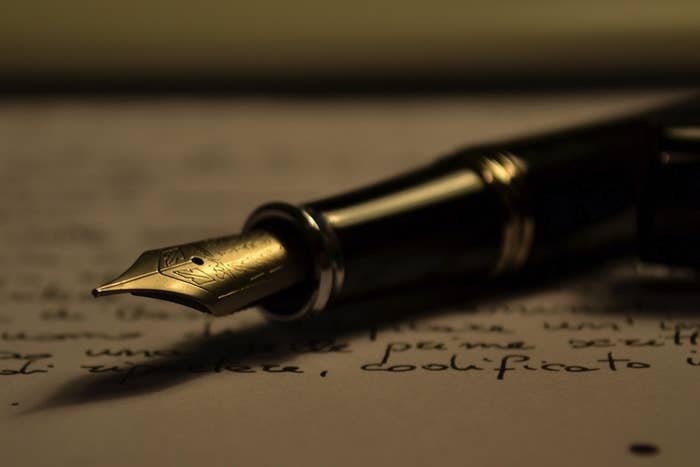
Readers love writers for their unique points of view. Is it at all surprising that their writing processes are equally unique? Here's proof that there is no "right" way to get the words on the paper:
"As he spent his days hunched in front of his computer, not writing, surfing relentlessly, feeling woolly-brained and lethargic, Nicolas became obsessed with other authors' writing processes, living authors, dead authors, best-selling ones, lesser-known ones, French, British, Indian, Spanish, Italian, Canadian, Turkish, American authors, any authors. He scoured the Internet for details on how they wrote. Many, it seemed, were inspired by events, conversations, or by other books. And once the idea took form, how did they actually write their novels? Nicolas thirsted for each and every element of information. How long did it take? Did they write notes? Did they research? Did they plan an outline? Was it detailed? Or did they simply sit down and write, like he had written The Envelope? Nicolas learned that Russell Banks did not enjoy writing fiction on his computer, as it cramped his flow. He wrote his first drafts by hand, with a rough outline to map his way. Nelson Novézan admitted that writing was such an agonizing business that he needed alcohol, drugs, and sex to get on with it and locked himself up in five-star hotel rooms. Margaret Atwood, who Tweeted as much as Nicolas did, printed out her chapters and stacked them on the floor, changing their order when she needed to. When she first got an idea for a novel, she had to write it down on the first scrap of paper she could find, even if it was a paper napkin. He discovered that Orhan Pamuk also wrote by hand, following a structured plot he doggedly stuck to. Michael Ondaatje literally clipped and pasted entire paper paragraphs into multilayered notebooks. Kazuo Ishiguro edited ruthlessly, cutting out parts that were over a hundred pages long. Jean d'Ormesson did the same, salvaging a mere three pages out of three hundred one summer. Katherine Pancol wore a pen around her neck to jot down ideas, ate chocolate and sipped tea while she worked. William Faulkner had drunk whiskey. F. Scott Fitzgerald had drank too much. W. H. Auden had swallowed Benzedrine. Charles Baudelaire had had to wrap his aching head in strips of cloth dipped in sedative water. Emile Zola had written best at Médan, his country home by the Seine. Daphne du Maurier had found her inspiration at Menabilly, her Cornwall estate, where she wrote in a gardener's hut under the trees in order to get away from her children. Ernest Hemingway had delivered five hundred words a day, every day. Ian McEwan, one thousand words. Tom Wolfe, eighteen hundred. Stephen King, two thousand. James Joyce needed one full day just to produce a couple of sentences. Georges Simenon had written a novel every four months and found the names of his heroes in the phone book. Vladimir Nabokov had written on index cards. Virginia Woolf, Victor Hugo, and Philip Roth wrote standing up. Truman Capote had to lie down with a coffee and a cigarette. Roald Dahl had slipped into a sleeping bag before sitting on his chair. Salman Rushdie wrote first thing in the morning, wearing his pajamas at the desk. Marcel Proust had written in bed late at night. So had Mark Twain. Haruki Murakami started to write at 4:00 A.M. So did Amélie Nothomb, using a blue ballpoint pen. Anthony Trollope from 5:30 A.M. to 8:30 A.M. Amos Oz took a forty-five minute walk at 6:00 A.M. and then got to work. Joyce Carol Oates preferred to write before breakfast. Toni Morrison wrote at dawn, in order to watch the sun come up. John Steinbeck had puffed away at a pipe. Guillaume Musso listened to jazz. Dorothy Parker had typed with two fingers. Serge Joncour wore earplugs and lifted dumbbells. Simone de Beauvoir had written eight hours a day, pausing for lunch. Paul Auster, six hours. Emily Dickinson had written on a tiny desk. Joanne Harris, in a stone shed built by her husband. Marc Levy, on a table made from an old door placed on trestles. The Brontë sisters, in their dining room. Nathalie Sarraute and Ismail Kadare, in cafés. P. D. James, in her kitchen. Jane Austen, in a room that had a squeaky door, which warned her of anyone's arrival. Gustave Flaubert had rewritten his sentences over and over again. Gabriel García Márquez could only work in familiar surroundings and never in hotels or on a borrowed typewriter. Annie Proulx started her stories by writing the ending first. Delphine de Vigan needed a long breather between two novels. Maupassant had needed women; Cocteau, opium. Nicolas stopped researching..."
— Tatiana de Rosnay, The Other Story
So get writing! And check out The Other Story, available in the US on April 15, 2014.


